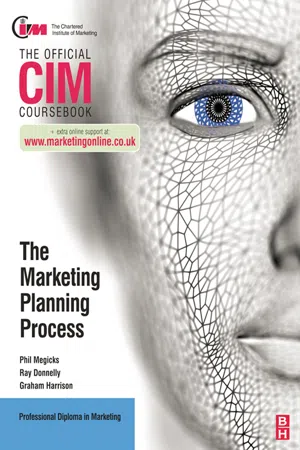
- 256 pages
- English
- ePUB (mobile friendly)
- Available on iOS & Android
CIM Coursebook: The Marketing Planning Process
About This Book
Butterworth-Heinemann's CIM Coursebooks have been designed to match the syllabus and learning outcomes of our new qualifications and should be useful aids in helping students understand the complexities of marketing. The discussion and practical application of theories and concepts, with relevant examples and case studies, should help readers make immediate use of their knowledge and skills gained from the qualifications.'
Professor Keith Fletcher, Director of Education, The Chartered Institute of Marketing 'Here in Dubai, we have used the Butterworth-Heinemann Coursebooks in their various forms since the very beginning and have found them most useful as a source of recommended reading material as well as examination preparation.'
Alun Epps, CIM Centre Co-ordinator, Dubai University College, United Arab Emirates Butterworth-Heinemann's official CIM Coursebooks are the definitive companions to the CIM professional marketing qualifications. The only study materials to be endorsed by The Chartered Institute of Marketing (CIM), all content is carefully structured to match the syllabus and is written in collaboration with the CIM faculty. Each chapter is packed full of case studies, study tips and activities to test your learning and understanding as you go along. •The coursebooks are the only study guide reviewed and approved by CIM (The Chartered Institute of Marketing).
•Each book is crammed with a range of learning objectives, cases, questions, activities, definitions, study tips and summaries to support and test your understanding of the theory.
•Past examination papers and examiners' reports are available online to enable you to practise what has been learned and help prepare for the exam and pass first time.
•Extensive online materials support students and tutors at every stage. Based on an understanding of student and tutor needs gained in extensive research, online materials have been designed specifically for CIM students and created exclusively for Butterworth-Heinemann. Check out exam dates on the Online Calendar, see syllabus links for each course, and access extra mini case studies to cement your understanding. Explore marketingonline.co.uk and access online versions of the coursebooks and further reading from Elsevier and Butterworth-Heinemann. INTERACTIVE, FLEXIBLE, ACCESSIBLE
ANY TIME, ANY PLACE
www.marketingonline.co.uk
Frequently asked questions
Information
Marketing Planning to Deliver Marketing Strategies
The Different Roles of Marketing and its Cross-Functional Interaction Within Organisations
Learning Objectives
- 1.1Critically evaluate the different roles of marketing and its cross-functional interaction within organisations
Syllabus References
- 1.1
- marketing as an organisational function and orientation
- marketing as a co-ordinating force in the organisation
- marketing’s interface with other organisational functions
- exchange, transactions and relationships
- markets, customers, competition and value creation
- marketers as planners, strategists and tacticians
- marketing in theory and in practice
Introduction
The Marketing Function
- defining markets
- quantifying the needs of the customer groups (segments) within these markets
- determining the value proposition to meet these needs
- communicating these value propositions to all those people in the organisation responsible for delivering them, and getting their buy-in to their role
- playing an appropriate part in delivering these value propositions (usually only communications)
- monitoring the value actually delivered
Marketing as an Orientation
The marketing concept holds that the key to achieving organisational goals lies in determining the needs and wants of target markets and delivering the desired satisfactions more efficiently and effectively than the competition.
- Customer focus
- Competitor focus
- Integrated functional co-ordination
- Organisational culture
- Long-term profits
- The generation of market information about the needs of customers and external environmental factors.
- The dissemination of such information across organisational functions.
- The development and implementation of strategies in response to the information.
| Sales orientation | The emphasis is on selling more of the products and services they have to customers. Little attention is paid to identifying and satisfying customer needs and wants. |
| Production orientation | Maximising output to obtain economies of scale to maximise profits. |
| Product orientation | The emphasis is on the product, but ignoring customer tastes may result in product failures or lost market to competitors. |
- Create a customer focus throughout the business
- Listen to the customer
- Target customers precisely
- Measure and manage customer expectations
- Build customer relationships and loyalty
- Commit to continuous improvement
- Manage profitability
- Manage the marketing culture
Marketing’s Interface with Other Organisational Functions
- A decision on a promotion, changing the credit terms, will have profound effects on credit collection and...
Table of contents
- Cover Page
- Half-Title Page
- Title Page
- Copyright Page
- Contents
- Foreword
- About the Authors
- Section 1: Marketing Planning to Deliver Marketing Strategies
- Section 2: The Marketing Audit and Strategic Outcomes
- Section 3: Creating Marketing Strategies Through Segmentation, Targeting and Positioning
- Section 4: Adapting Marketing Planning in Different Contexts
- Index